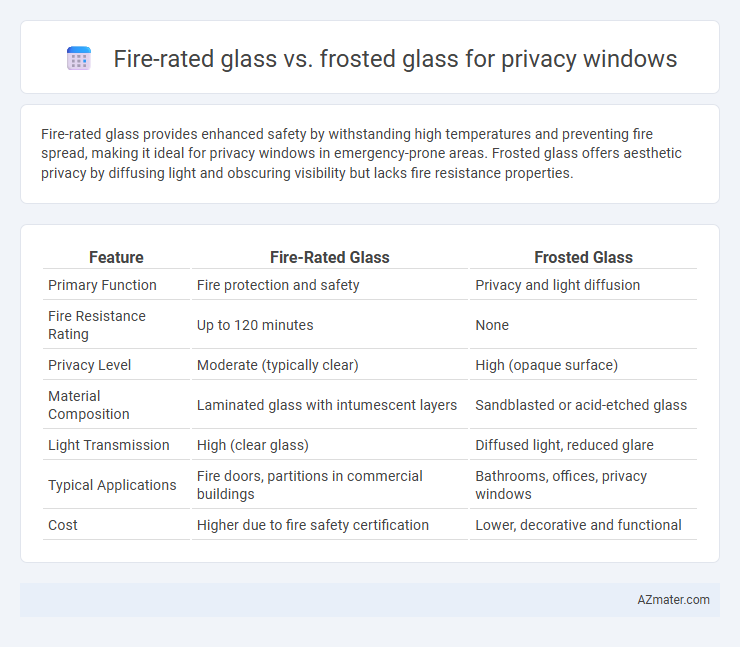Fire-rated glass provides enhanced safety by withstanding high temperatures and preventing fire spread, making it ideal for privacy windows in emergency-prone areas. Frosted glass offers aesthetic privacy by diffusing light and obscuring visibility but lacks fire resistance properties.
Table of Comparison
| Feature | Fire-Rated Glass | Frosted Glass |
|---|---|---|
| Primary Function | Fire protection and safety | Privacy and light diffusion |
| Fire Resistance Rating | Up to 120 minutes | None |
| Privacy Level | Moderate (typically clear) | High (opaque surface) |
| Material Composition | Laminated glass with intumescent layers | Sandblasted or acid-etched glass |
| Light Transmission | High (clear glass) | Diffused light, reduced glare |
| Typical Applications | Fire doors, partitions in commercial buildings | Bathrooms, offices, privacy windows |
| Cost | Higher due to fire safety certification | Lower, decorative and functional |
Introduction to Privacy Windows
Fire-rated glass provides exceptional safety by resisting high temperatures while maintaining visibility, making it ideal for privacy windows in commercial buildings requiring both fire protection and subtle transparency. Frosted glass enhances privacy by diffusing light and obscuring detailed views, commonly used in residential and office settings where natural light is desired without compromising confidentiality. Both materials serve privacy needs, but fire-rated glass integrates safety standards that cater to strict building codes, whereas frosted glass prioritizes aesthetic appeal and visual separation.
What is Fire-Rated Glass?
Fire-rated glass is a specially engineered glass designed to withstand high temperatures and prevent the spread of flames and smoke during a fire, making it ideal for enhancing safety in buildings. Unlike frosted glass, which primarily offers privacy by diffusing light and obscuring vision, fire-rated glass combines visibility with critical fire resistance properties, meeting stringent building codes and fire safety regulations. It typically consists of multiple layers, including intumescent materials that expand when heated to maintain integrity and protect occupants during emergencies.
What is Frosted Glass?
Frosted glass is a type of privacy glass created by sandblasting or acid etching clear glass to produce a translucent, matte finish that obscures visibility while allowing natural light to pass through. Unlike fire-rated glass, which is engineered to withstand high temperatures and prevent the spread of flames and smoke, frosted glass primarily enhances privacy and aesthetic appeal without providing fire resistance. It is commonly used in bathrooms, office partitions, and privacy windows where light diffusion and visual obscuration are desired.
Privacy Performance: Fire-Rated vs Frosted Glass
Fire-rated glass offers robust privacy by maintaining integrity under high temperatures and preventing fire and smoke passage, which is critical for safety and containment but often features limited opacity. Frosted glass excels in privacy performance by obscuring visibility through its translucent texture, providing effective visual barrier while allowing natural light diffusion. Choosing between fire-rated and frosted glass for privacy windows depends on whether fire containment or visual obstruction is the primary concern, as fire-rated glass prioritizes safety standards while frosted glass prioritizes maximum privacy.
Fire Safety Considerations
Fire-rated glass is engineered to withstand high temperatures and prevent the spread of flames and smoke, making it crucial for fire safety in privacy windows within commercial and residential buildings. Frosted glass, while offering privacy, lacks the heat resistance and fire containment properties required by fire safety codes. Choosing fire-rated glass ensures compliance with regulations and enhances building safety without compromising on privacy.
Aesthetic Appeal and Design Options
Fire-rated glass offers a sleek, transparent aesthetic that enhances modern architectural designs while providing essential safety benefits, making it ideal for spaces requiring both visibility and fire protection. Frosted glass delivers a soft, diffused light effect with varying opacity levels, allowing for customizable privacy without sacrificing natural illumination, suited for elegant and subtle interior designs. Both options present diverse design possibilities, with fire-rated glass accommodating clear, wired, or tinted variants, and frosted glass available in patterns, textures, and gradient finishes to complement different stylistic preferences.
Light Transmission and Visibility
Fire-rated glass offers high light transmission while maintaining clear visibility, ensuring safety without compromising natural light flow. Frosted glass reduces visibility significantly by diffusing light, providing enhanced privacy but diminishing the clarity of objects seen through it. Choosing between these options depends on balancing the need for fire protection and privacy with desired levels of daylight penetration and visual clarity.
Cost Comparison and Value
Fire-rated glass typically incurs higher upfront costs compared to frosted glass due to its enhanced safety standards and specialized manufacturing processes designed to withstand high temperatures. Frosted glass offers a more budget-friendly option for privacy windows, providing effective obscuration at a lower price point but lacking fire resistance features. Considering long-term value, fire-rated glass can justify its premium cost in commercial or safety-critical environments by combining privacy with fire protection, whereas frosted glass suits residential or less stringent applications where cost-efficiency is a priority.
Installation and Maintenance Requirements
Fire-rated glass requires professional installation to meet strict safety codes and must be sealed with fire-resistant materials, ensuring structural integrity and fire containment. Maintenance involves regular inspections for damages or cracks to guarantee fire safety compliance, often requiring specialized cleaning agents that do not compromise its protective properties. Frosted glass offers simpler installation with standard framing and non-specialized sealing, and its maintenance typically involves routine cleaning without special considerations, making it more user-friendly but less protective in fire scenarios.
Choosing the Right Glass for Your Privacy Window
Choosing the right glass for your privacy window involves balancing safety and aesthetics; fire-rated glass offers enhanced heat resistance and safety compliance while maintaining partial visibility. Frosted glass provides maximum privacy by obscuring views but lacks fire resistance, making it ideal for residential or office settings with less stringent safety requirements. Prioritize fire-rated glass in commercial or high-risk environments where building codes demand fire protection alongside privacy.

Infographic: Fire-rated glass vs Frosted glass for Privacy window
 azmater.com
azmater.com